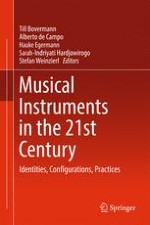2017 | OriginalPaper | Chapter
From Musical Instruments as Ontological Entities to Instrumental Quality: A Linguistic Exploration of Musical Instrumentality in the Digital Era
Author : Caroline Cance
Published in: Musical Instruments in the 21st Century
Publisher: Springer Singapore
Activate our intelligent search to find suitable subject content or patents.
Select sections of text to find matching patents with Artificial Intelligence. powered by
Select sections of text to find additional relevant content using AI-assisted search. powered by
